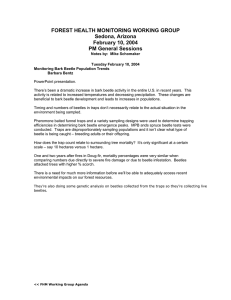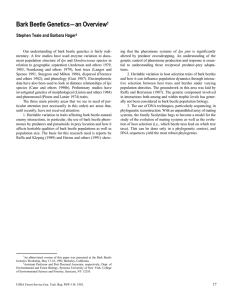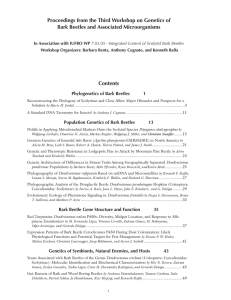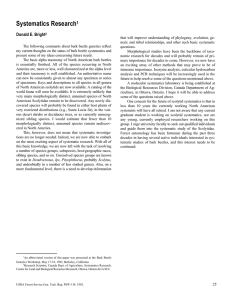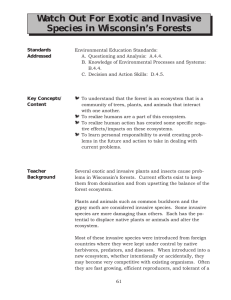Commentary Tree physiology and bark beetles
advertisement
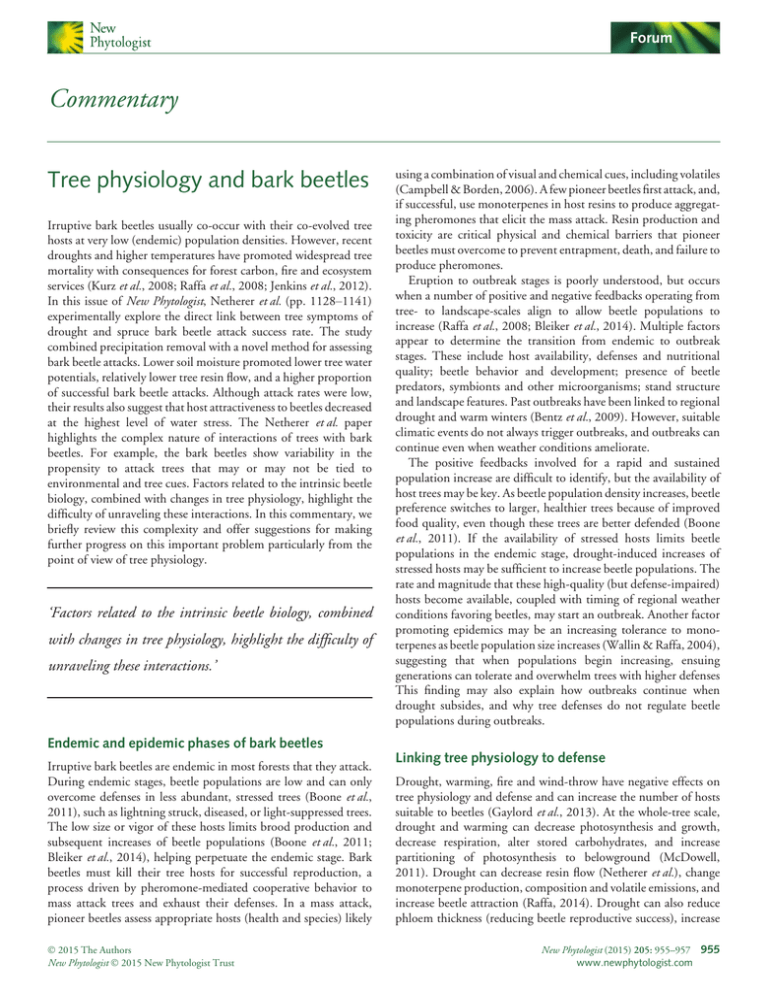
Forum Commentary Tree physiology and bark beetles Irruptive bark beetles usually co-occur with their co-evolved tree hosts at very low (endemic) population densities. However, recent droughts and higher temperatures have promoted widespread tree mortality with consequences for forest carbon, fire and ecosystem services (Kurz et al., 2008; Raffa et al., 2008; Jenkins et al., 2012). In this issue of New Phytologist, Netherer et al. (pp. 1128–1141) experimentally explore the direct link between tree symptoms of drought and spruce bark beetle attack success rate. The study combined precipitation removal with a novel method for assessing bark beetle attacks. Lower soil moisture promoted lower tree water potentials, relatively lower tree resin flow, and a higher proportion of successful bark beetle attacks. Although attack rates were low, their results also suggest that host attractiveness to beetles decreased at the highest level of water stress. The Netherer et al. paper highlights the complex nature of interactions of trees with bark beetles. For example, the bark beetles show variability in the propensity to attack trees that may or may not be tied to environmental and tree cues. Factors related to the intrinsic beetle biology, combined with changes in tree physiology, highlight the difficulty of unraveling these interactions. In this commentary, we briefly review this complexity and offer suggestions for making further progress on this important problem particularly from the point of view of tree physiology. ‘Factors related to the intrinsic beetle biology, combined with changes in tree physiology, highlight the difficulty of unraveling these interactions.’ using a combination of visual and chemical cues, including volatiles (Campbell & Borden, 2006). A few pioneer beetles first attack, and, if successful, use monoterpenes in host resins to produce aggregating pheromones that elicit the mass attack. Resin production and toxicity are critical physical and chemical barriers that pioneer beetles must overcome to prevent entrapment, death, and failure to produce pheromones. Eruption to outbreak stages is poorly understood, but occurs when a number of positive and negative feedbacks operating from tree- to landscape-scales align to allow beetle populations to increase (Raffa et al., 2008; Bleiker et al., 2014). Multiple factors appear to determine the transition from endemic to outbreak stages. These include host availability, defenses and nutritional quality; beetle behavior and development; presence of beetle predators, symbionts and other microorganisms; stand structure and landscape features. Past outbreaks have been linked to regional drought and warm winters (Bentz et al., 2009). However, suitable climatic events do not always trigger outbreaks, and outbreaks can continue even when weather conditions ameliorate. The positive feedbacks involved for a rapid and sustained population increase are difficult to identify, but the availability of host trees may be key. As beetle population density increases, beetle preference switches to larger, healthier trees because of improved food quality, even though these trees are better defended (Boone et al., 2011). If the availability of stressed hosts limits beetle populations in the endemic stage, drought-induced increases of stressed hosts may be sufficient to increase beetle populations. The rate and magnitude that these high-quality (but defense-impaired) hosts become available, coupled with timing of regional weather conditions favoring beetles, may start an outbreak. Another factor promoting epidemics may be an increasing tolerance to monoterpenes as beetle population size increases (Wallin & Raffa, 2004), suggesting that when populations begin increasing, ensuing generations can tolerate and overwhelm trees with higher defenses This finding may also explain how outbreaks continue when drought subsides, and why tree defenses do not regulate beetle populations during outbreaks. Endemic and epidemic phases of bark beetles Irruptive bark beetles are endemic in most forests that they attack. During endemic stages, beetle populations are low and can only overcome defenses in less abundant, stressed trees (Boone et al., 2011), such as lightning struck, diseased, or light-suppressed trees. The low size or vigor of these hosts limits brood production and subsequent increases of beetle populations (Boone et al., 2011; Bleiker et al., 2014), helping perpetuate the endemic stage. Bark beetles must kill their tree hosts for successful reproduction, a process driven by pheromone-mediated cooperative behavior to mass attack trees and exhaust their defenses. In a mass attack, pioneer beetles assess appropriate hosts (health and species) likely Ó 2015 The Authors New Phytologist Ó 2015 New Phytologist Trust Linking tree physiology to defense Drought, warming, fire and wind-throw have negative effects on tree physiology and defense and can increase the number of hosts suitable to beetles (Gaylord et al., 2013). At the whole-tree scale, drought and warming can decrease photosynthesis and growth, decrease respiration, alter stored carbohydrates, and increase partitioning of photosynthesis to belowground (McDowell, 2011). Drought can decrease resin flow (Netherer et al.), change monoterpene production, composition and volatile emissions, and increase beetle attraction (Raffa, 2014). Drought can also reduce phloem thickness (reducing beetle reproductive success), increase New Phytologist (2015) 205: 955–957 955 www.newphytologist.com 956 Forum Commentary phloem viscosity and sugar concentration, and reduce the effectiveness of tree defenses against the fungi introduced with beetle attack (Croise & Lieutier, 1993). Linking the better-studied components (growth and photosynthesis), with the poorly studied components (carbohydrate storage, resin production, volatile emissions) will help identify physiological mechanisms that control these components. For example, drought may reduce carbon availability for resin production (McDowell, 2011), but drought could also lower connectivity in the resin canal network, impair resin exudation by reducing turgor pressure exerted on resin canals, limit flow through increased viscosity, reduce carbohydrate availability through impairment of phloem transport or storage availability, and reduce induced defenses. Understanding the links between tree physiology and tree defense under the endemic and transition-to-epidemic phases will enable a better understanding and predictability of bark beetle epidemics. A way forward Understanding tree resistance, attractiveness, and defense for bark beetles is a complex problem where interactions play a substantial role. We believe that such a complex system is best approached using an integrative approach. Such an approach would include concurrent measurements of all the relevant components of the system, including carbon and water status, and resin and volatile production and composition of the tree hosts, the intensity of drought, and bark beetle population density and developmental stage (Fig. 1). The Netherer et al. study has many of these components and serves to stimulate future studies. However, additional complementary measurements would allow a more mechanistic interpretation of results. For example, measurements of photosynthesis, carbohydrate pools, and phloem flow would have enabled a better understanding of the link between resin New Phytologist production and tree carbon and water status. Similarly, measurements of volatile flux and composition would have allowed better interpretation of the patterns in beetle attack. Combining these measurements with tree growth and phloem thickness measurements and local beetle population status and activity would provide further information about tree attractiveness to beetles. The novel beetle ‘attack box’ method outlined in the Netherer et al. study represents a real advance, because the trees and beetles themselves provide an integrated answer. However, for future application such methodology should be optimized for box size and number of beetles. Finally, simple metrics such as growth efficiency (Waring & Pitman, 1985) may be used to rank experimental trees by their likely susceptibility to bark beetle attack and reduce experimental variability. Another method for reducing the enormous variability of field experiments would be to examine the links between tree physiology, defense and attractiveness using small trees in a controlled glasshouse environment, where individual components can be separately modified. Assessing some components of tree physiology is simple (leaf water potential, relative water content (RWC), osmotic potential), but linking these with carbohydrate storage, tree carbon economy, and resin and volatile production and composition is very difficult. Because this system is so complex, experiments in a controlled environment are likely the best way to make the concurrent measurements necessary to disentangle the mechanisms between tree physiology and defense. While attractiveness to bark beetles might be measured, trees in a glasshouse would be too small to be attacked. However, such controlled experiments could answer questions that could then be tested in the field, such as: What are the best metrics to identify a stressed tree that is attractive to beetles, particularly the pioneer beetles? How does drought change tree attractiveness to beetles, and how is this linked with the tree’s carbon, water, and nutrient metabolism? How long do drought effects on tree physiology persist after the end of Fig. 1 Effects of severe drought and stand density on tree host factors influencing and interacting with bark beetle life cycle stages. The + and for stand density and severe drought show the potential correlations of tree host factors with the component that interacts with the bark beetles. New Phytologist (2015) 205: 955–957 www.newphytologist.com Ó 2015 The Authors New Phytologist Ó 2015 New Phytologist Trust New Phytologist Commentary drought? Field and controlled environment experiments that focus on the tree physiology and bark beetle interactions during the endemic stage or the transition from the endemic to outbreak stages will likely prove the most useful for predicting future outbreaks. Michael G. Ryan1,2*, Gerard Sapes3, Anna Sala3 and Sharon M. Hood3 1 Natural Resources Ecology Laboratory and Graduate Degree Program in Ecology, Colorado State University, Fort Collins, CO 80523-1499, USA; 2 USDA Forest Service, Rocky Mountain Research Station, Fort Collins, CO, 80521, USA; 3 Division of Biological Sciences, The University of Montana, Missoula, MT 59812, USA (*Author for correspondence: tel +1 970 217 5798; email Mike.Ryan@colostate.edu) References Bentz B, Logan J, MacMahon J, Allen CD, Ayres M, Berg E, Carroll A, Hansen M, Hicke J, Joyce L. 2009. Bark beetle outbreaks in western North America: causes and consequences. Salt Lake City, UT, USA: University of Utah Press. Bleiker KP, O’Brien MR, Smith GD, Carroll AL. 2014. Characterisation of attacks made by the mountain pine beetle (Coleoptera: Curculionidae) during its endemic population phase. The Canadian Entomologist 146: 271–284. Boone CK, Aukema BH, Bohlmann J, Carroll AL, Raffa KF. 2011. Efficacy of tree defense physiology varies with bark beetle population density: a basis for positive feedback in eruptive species. Canadian Journal of Forest Research 41: 1174–1188. Campbell SA, Borden JH. 2006. Close-range, in-flight integration of olfactory and visual information by a host-seeking bark beetle. Entomologia Experimentalis et Applicata 120: 91–98. Forum 957 Croise L, Lieutier F. 1993. Effects of drought on the induced defense reaction of scots pine to bark beetle-associated fungi. Annales des Sciences Forestieres 50: 91– 97. Gaylord ML, Kolb TE, Pockman WT, Plaut JA, Yepez EA, Macalady AK, Pangle RE, McDowell NG. 2013. Drought predisposes pinon–juniper woodlands to insect attacks and mortality. New Phytologist 198: 567–578. Jenkins MJ, Page WG, Hebertson EG, Alexander ME. 2012. Fuels and fire behavior dynamics in bark beetle-attacked forests in Western North America and implications for fire management. Forest Ecology and Management 275: 23–34. Kurz WA, Stinson G, Rampley GJ, Dymond CC, Neilson ET. 2008. Risk of natural disturbances makes future contribution of Canada’s forests to the global carbon cycle highly uncerain. Proceedings of the National Academy of Sciences, USA 105: 1551–1555. McDowell NG. 2011. Mechanisms linking drought, hydraulics, carbon metabolism, and vegetation mortality. Plant Physiology 155: 1051–1059. Netherer S, Matthews B, Katzensteiner K, Blackwell E, Henschke P, Hietz P, Pennerstorfer J, Rosner S, Kikuta S, Schume H et al. 2015. Do water limiting conditions predispose Norway spruce to bark beetle attack? New Phytologist 205: 1128–1141. Raffa KF. 2014. Terpenes tell different tales at different scales: glimpses into the chemical ecology of conifer–bark beetle–microbial interactions. Journal of Chemical Ecology 40: 1–20. Raffa KF, Aukema BH, Bentz BJ, Carroll AL, Hicke JA, Turner MG, Romme WH. 2008. Cross-scale drivers of natural disturbances prone to anthropogenic amplification: the dynamics of bark beetle eruptions. BioScience 58: 501–517. Wallin KF, Raffa KF. 2004. Feedback between individual host selection behavior and population dynamics in an eruptive herbivore. Ecological Monographs 74: 101–116. Waring RH, Pitman GB. 1985. Modifying lodgepole pine stands to change susceptibility to mountain pine beetle attack. Ecology 66: 889–897. Key words: drought, induced defense, irruptive bark beetles, resin production, tree mortality. www.newphytologist.com np-usaoffice@lancaster.ac.uk np-centraloffice@lancaster.ac.uk www.newphytologist.com Ó 2015 The Authors New Phytologist Ó 2015 New Phytologist Trust New Phytologist (2015) 205: 955–957 www.newphytologist.com
